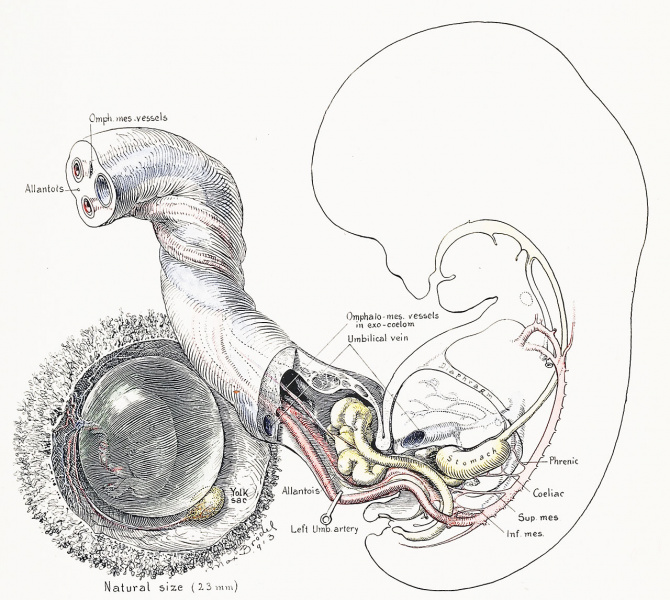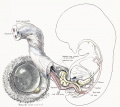File:Cullen1916 fig11.jpg

Original file (1,280 × 1,146 pixels, file size: 320 KB, MIME type: image/jpeg)
Fig. 11. Sagittal Section of the Umbilical Region in a Human Embryo 23 mm in Length
The small drawing to the left, which is of natural size, accurately depicts the relation of the yolk-sac to the cord and amnion. Its stalk is very long, and the yolk-sac has become relatively smaller. The umbilical cord now shows very marked twisting. The exoccelomic cavity in the umbilical cord now contains practically all the intestine with the exception of the jejunum and descending colon. The distal portion of the cavity is funnel-shaped, the apex being directed away from the embryo. The omphalomesenteric duct has disappeared, but its vessels persist. The small cystic spaces in the upper wall of the cord mark the beginning obliteration of the exoccelom. The umbilical vein has been partly removed in order to bring into view the deeper structures. The two umbilical arteries, accompanied by the allantois, are in their usual position in the lower part of the cord. Note the slight spindle-shaped dilatation of the allantois in its course.
| Historic Disclaimer - information about historic embryology pages |
|---|
| Pages where the terms "Historic" (textbooks, papers, people, recommendations) appear on this site, and sections within pages where this disclaimer appears, indicate that the content and scientific understanding are specific to the time of publication. This means that while some scientific descriptions are still accurate, the terminology and interpretation of the developmental mechanisms reflect the understanding at the time of original publication and those of the preceding periods, these terms, interpretations and recommendations may not reflect our current scientific understanding. (More? Embryology History | Historic Embryology Papers) |
- Figure Links: 1 Human embryo 0.7 mm | 2 Human embryo 1.7 mm | 3 Human embryo 2.5 mm | 4 Human embryo 3.5 mm | 5 Human embryo 5 mm | 6 Human embryo 7 mm | 7 Human embryo 7 mm | 8 Human embryo 10 mm | 9 Human embryo 12.5 mm | 10 Human embryo 10 mm | 11 Human embryo 23 mm | 12 Human embryo 3 cm | 13 Human embryo 4.5 cm sagittal | 14 Human Embryo 4.5 cm | 15 Human Embryo 5.2 cm | 16 Human Embryo 6.5 cm | 17 Human Embryo 7.5 cm | 18 Human Embryo 9 cm | 19 Human Embryo 10 cm | 20 Human Embryo 12 cm | 21 Human Embryo 12 cm | 22 Human Embryo 12 cm | 23 Human Embryo 12 cm Cord | 28 Fetus Five Months | 30 Ventral Heria | 31 Human Embryo 5.5 cm | 32 Term Human | 33 Term Human | [[Figures
Reference
Cullen TS. Embryology, anatomy, and diseases of the umbilicus together with diseases of the urachus. (1916) W. B. Saunders Company, Philadelphia And London.
Cite this page: Hill, M.A. (2024, April 27) Embryology Cullen1916 fig11.jpg. Retrieved from https://embryology.med.unsw.edu.au/embryology/index.php/File:Cullen1916_fig11.jpg
- © Dr Mark Hill 2024, UNSW Embryology ISBN: 978 0 7334 2609 4 - UNSW CRICOS Provider Code No. 00098G
File history
Click on a date/time to view the file as it appeared at that time.
| Date/Time | Thumbnail | Dimensions | User | Comment | |
|---|---|---|---|---|---|
| current | 17:14, 27 October 2018 |  | 1,280 × 1,146 (320 KB) | Z8600021 (talk | contribs) | |
| 17:14, 27 October 2018 |  | 2,096 × 2,381 (1,006 KB) | Z8600021 (talk | contribs) | Fig. 11. Sagittal Section of the Umbilical Region in a Human Embryo 23 mm. in Length. The small drawing to the left, which is of natural size, accurately depicts the relation of the yolk-sac to the cord and amnion. Its stalk is very long, and the yol... |
You cannot overwrite this file.
File usage
The following 3 pages use this file:
